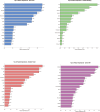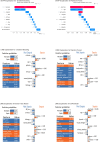Interpretable machine learning for predicting sepsis risk in emergency triage patients
- PMID: 39762406
- PMCID: PMC11704257
- DOI: 10.1038/s41598-025-85121-z
Interpretable machine learning for predicting sepsis risk in emergency triage patients
Abstract
The study aimed to develop and validate a sepsis prediction model using structured electronic medical records (sEMR) and machine learning (ML) methods in emergency triage. The goal was to enhance early sepsis screening by integrating comprehensive triage information beyond vital signs. This retrospective cohort study utilized data from the MIMIC-IV database. Two models were developed: Model 1 based on vital signs alone, and Model 2 incorporating vital signs, demographic characteristics, medical history, and chief complaints. Eight ML algorithms were employed, and model performance was evaluated using metrics such as AUC, F1 Score, and calibration curves. SHapley Additive exPlanations (SHAP) and Local Interpretable Model-agnostic Explanations (LIME) methods were used to enhance model interpretability. The study included 189,617 patients, with 5.95% diagnosed with sepsis. Model 2 consistently outperformed Model 1 across most algorithms. In Model 2, Gradient Boosting achieved the highest AUC of 0.83, followed by Extra Tree, Random Forest, and Support Vector Machine (all 0.82). The SHAP method provided more comprehensible explanations for the Gradient Boosting algorithm. Modeling with comprehensive triage information using sEMR and ML methods was more effective in predicting sepsis at triage compared to using vital signs alone. Interpretable ML enhanced model transparency and provided sepsis prediction probabilities, offering a feasible approach for early sepsis screening and aiding healthcare professionals in making informed decisions during the triage process.
Keywords: Emergency; Interpretable machine learning; Sepsis; Triage; Warning mode.
© 2025. The Author(s).
Conflict of interest statement
Declarations. Competing interests: The authors declare no competing interests. Ethics declarations: The data for this study came from a public database. The study design was approved by the appropriate ethics review board. Informed consent was not necessary because the database used was anonymized.
Figures





Similar articles
-
Development and validation of interpretable machine learning models for triage patients admitted to the intensive care unit.PLoS One. 2025 Feb 18;20(2):e0317819. doi: 10.1371/journal.pone.0317819. eCollection 2025. PLoS One. 2025. PMID: 39964993 Free PMC article.
-
Interpretable machine learning model for early prediction of 28-day mortality in ICU patients with sepsis-induced coagulopathy: development and validation.Eur J Med Res. 2024 Jan 3;29(1):14. doi: 10.1186/s40001-023-01593-7. Eur J Med Res. 2024. PMID: 38172962 Free PMC article.
-
Machine learning algorithms for early sepsis detection in the emergency department: A retrospective study.Int J Med Inform. 2022 Apr;160:104689. doi: 10.1016/j.ijmedinf.2022.104689. Epub 2022 Jan 20. Int J Med Inform. 2022. PMID: 35078027
-
A Machine Learning Approach to Predicting Need for Hospitalization for Pediatric Asthma Exacerbation at the Time of Emergency Department Triage.Acad Emerg Med. 2018 Dec;25(12):1463-1470. doi: 10.1111/acem.13655. Epub 2018 Nov 29. Acad Emerg Med. 2018. PMID: 30382605
-
Improving triage performance in emergency departments using machine learning and natural language processing: a systematic review.BMC Emerg Med. 2024 Nov 18;24(1):219. doi: 10.1186/s12873-024-01135-2. BMC Emerg Med. 2024. PMID: 39558255 Free PMC article.
Cited by
-
The ethics of data mining in healthcare: challenges, frameworks, and future directions.BioData Min. 2025 Jul 11;18(1):47. doi: 10.1186/s13040-025-00461-w. BioData Min. 2025. PMID: 40646553 Free PMC article. Review.
-
Evaluating the impact of common clinical confounders on performance of deep-learning-based sepsis risk assessment.Front Artif Intell. 2025 Jul 15;8:1452471. doi: 10.3389/frai.2025.1452471. eCollection 2025. Front Artif Intell. 2025. PMID: 40735113 Free PMC article.
-
Machine Learning and Deep Learning Models for Early Sepsis Prediction: A Scoping Review.Indian J Crit Care Med. 2025 Jun;29(6):516-524. doi: 10.5005/jp-journals-10071-24986. Epub 2025 Jun 5. Indian J Crit Care Med. 2025. PMID: 40567322 Free PMC article. Review.
References
-
- Yealy, D. M. et al. Early care of adults with suspected sepsis in the emergency department and out-of-hospital environment: A consensus-based task force report. Ann. Emerg. Med.78, 1–19. 10.1016/j.annemergmed.2021.02.006 (2021). - PubMed
-
- Rhodes, A. et al. Surviving sepsis campaign: International guidelines for management of sepsis and septic shock: 2016. Intensive Care Med.43, 304–377. 10.1007/s00134-017-4683-6 (2017). - PubMed
-
- Kalich, B. A. et al. Impact of an antibiotic-specific sepsis bundle on appropriate and timely antibiotic administration for severe sepsis in the emergency department. J. Emerg. Med.50, 79-88.e71. 10.1016/j.jemermed.2015.09.007 (2016). - PubMed
-
- Levy, M. M., Evans, L. E. & Rhodes, A. The Surviving Sepsis Campaign Bundle: 2018 update. Intensive Care Med.44, 925–928. 10.1007/s00134-018-5085-0 (2018). - PubMed
Publication types
MeSH terms
Grants and funding
LinkOut - more resources
Full Text Sources
Medical
Research Materials

